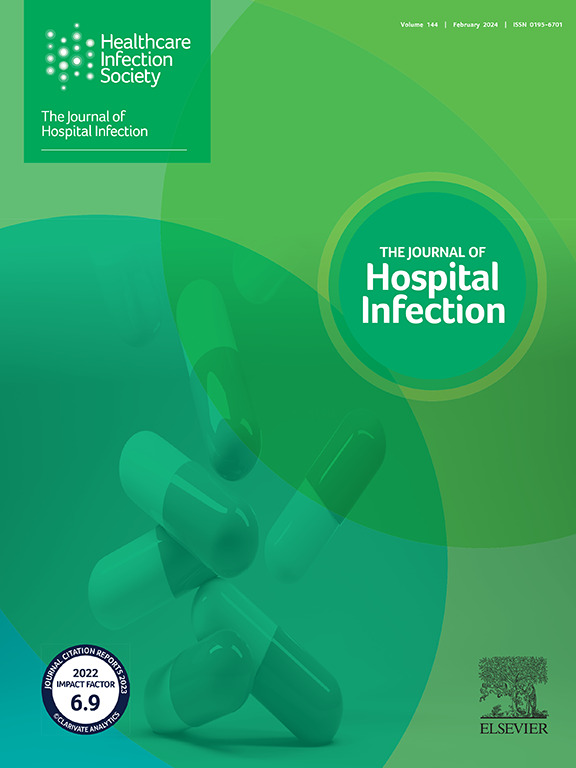全国麻醉科手卫生状况调查。
IF 3.1
3区 医学
Q1 INFECTIOUS DISEASES
引用次数: 0
摘要
目的:了解麻醉人员手卫生知识和习惯的现状,为提高医护人员的手卫生水平提供参考。材料与方法:于2024年11月1日至12月31日在全国范围内进行横断面在线调查,调查对象为我国医院麻醉工作人员。问卷由一个多学科小组编制,涵盖社会人口统计学、手卫生习惯、熟练程度和知识。2580份问卷中,经质控有效问卷2512份。使用描述性统计、卡方检验和逻辑回归分析数据并确定手卫生依从性的预测因素。结果:共分析有效问卷2512份,主要来自男性麻醉医师(分别占90.84%和59.39%)。以三级甲等医院为主(60.67%)。绝大多数人接受过正式的手部卫生培训(94.43%),并定期获得洗手液(90.61%),超过三分之二的人报告有足够的消毒和洗涤时间(66.44%和67.27%),并高度遵守七步法(81.76%)。坚持洗手的障碍包括“太忙”(66.28%)、手巾供应不足(41.68%)、认为“手套代替洗手”(39.93%)和设施不足(18.91%)。手卫生评定的平均知识分为61.02分,平均实践分为80.36分,平均熟练分为82.62分。更高的知识和正规培训与更好地遵守所建议的做法有关。结论:本研究强调了改善中国麻醉人员手部卫生习惯的必要性,强调了培训、知识和解决依从性障碍的作用。本文章由计算机程序翻译,如有差异,请以英文原文为准。
Investigation on hand hygiene in anaesthesiology departments in China
Objective
To investigate the current status of hand hygiene practices and knowledge among anaesthesiology personnel in China, providing a reference for improving hand hygiene standards among healthcare workers.
Methods
A cross-sectional nationwide online survey was conducted from 1st November to 31st December 2024, targeting anaesthesiology staff in Chinese hospitals. Developed by a multi-disciplinary team, the questionnaire covered sociodemographics, hand hygiene practices, proficiency and knowledge. Of 2580 responses, 2512 were valid after quality control. Descriptive statistics, Chi-squared tests and logistic regression were used to analyse the data and identify predictors of hand hygiene compliance.
Results
The study analysed 2512 valid responses, mostly from male anaesthesiologists (90.84% and 59.39% for males and females, respectively). Most participants were from Class IIIA hospitals (60.67%). A large majority of participants had formal hand hygiene training (94.43%) and regular access to hand sanitizers (90.61%), with over two-thirds reporting adequate disinfection and washing durations (66.44% and 67.27%, respectively) and high adherence to the seven-step technique (81.76%). Barriers to adherence included being ‘too busy’ (66.28%), insufficient hand towel availability (41.68%), the belief that ‘gloves substitute for handwashing’ (39.93%), and inadequate facilities (18.91%). The hand hygiene assessment showed a mean knowledge score of 61.02, a mean practice score of 80.36, and a mean proficiency score of 82.62. Higher knowledge and formal training were linked to better compliance with recommended practices.
Conclusions
This study highlights the need for improved hand hygiene practices among anaesthesiology personnel in China, emphasizing the roles of training, knowledge, and addressing barriers to compliance.
求助全文
通过发布文献求助,成功后即可免费获取论文全文。
去求助
来源期刊

Journal of Hospital Infection
医学-传染病学
CiteScore
12.70
自引率
5.80%
发文量
271
审稿时长
19 days
期刊介绍:
The Journal of Hospital Infection is the editorially independent scientific publication of the Healthcare Infection Society. The aim of the Journal is to publish high quality research and information relating to infection prevention and control that is relevant to an international audience.
The Journal welcomes submissions that relate to all aspects of infection prevention and control in healthcare settings. This includes submissions that:
provide new insight into the epidemiology, surveillance, or prevention and control of healthcare-associated infections and antimicrobial resistance in healthcare settings;
provide new insight into cleaning, disinfection and decontamination;
provide new insight into the design of healthcare premises;
describe novel aspects of outbreaks of infection;
throw light on techniques for effective antimicrobial stewardship;
describe novel techniques (laboratory-based or point of care) for the detection of infection or antimicrobial resistance in the healthcare setting, particularly if these can be used to facilitate infection prevention and control;
improve understanding of the motivations of safe healthcare behaviour, or describe techniques for achieving behavioural and cultural change;
improve understanding of the use of IT systems in infection surveillance and prevention and control.
 求助内容:
求助内容: 应助结果提醒方式:
应助结果提醒方式:


